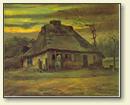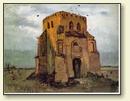| Relevant paintings: 
"Cottage at Nightfall," Vincent van Gogh
[Enlarge]

"Old Cemetery Tower at Nuenen," Vincent van Gogh
[Enlarge]
|
Dear Theo,
Today being Sunday, I want to write you again.
Because I forgot to say something of Uhde's picture,
“Laissez venir à moi les petits
enfants.”
Yes, I like it, but it isn't new.
And I prefer interiors in a bright tone with peasant
children, without a mystic figure of Christ, as
Israëls or Artz paint them, to this one, where one gets a
mystic Christ into the bargain.
The children are very expressive - but are they better than
those by Labrichon, Frère or even Knaus, Vautier (in
their best period)?
Do not think this unimportant, for all those people I
mention were, especially in the past, extraordinarily clever in
expressing character.
My objection to Uhde's picture is that there is a certain
coldness in it like in new brick houses and schools and the
Methodist churches. And notwithstanding the great merits of the
picture, excuse me, but it makes me long for Decamps's or
Isabey's less orthodox style of painting.
There is after all something consumptive in it, and I think
a Corot, a Dupré, a Millet, infinitely healthier in
tone.
But I can only judge from the reproduction; perhaps if I saw
the picture, I should get more reconciled to it as to
technique.
You know how much I like the bright painters too, but you
see it goes too far, and Mantz expresses it very subtly when he
says, “Ceux qui rêvent toujours partout le maximum
des clairs, trouveraient d'une intensité un peu noire
les verts de M. Harpignies” [those who are forever and
everywhere dreaming of the maximum of light tones would find
Mr. Harpignies's greens somewhat black].
That's it exactly: They begin to find heresy in every effect
against a strong and coloured light, in every shadow - they
never seem to walk early in the morning or in the evening at
sunset - they want to see nothing but full daylight, or
gaslight, or even electric light!
Now, the effect of all this on me is that I sometimes detect
in myself a longing to see things like, for instance,
“The Moving Out” by Nuyen, like an old Leys, like a
Cabat, a Diaz, or Lepoitevin.
Perhaps you will call this nothing but my constant
waywardness. But I begin by admitting that I find Uhde's
picture very good; only having found it good, I became
conscious of an aftertaste that is not altogether peasant, at
least not cheering, because that kind of painter generally
doesn't improve in his later pictures.
Well, it is a typical picture for the house Goupil &
Co.; of their best. They have also had Knaus at Goupil's, and
Labrichon too. I assure you that I do not systematically
despise all this, far from it. Does it express what I mean when
I say it thus: “It is a good picture of Messrs.
Goupil & Co.'s?” Does it express what I mean when I
say, “Beaucoup, mais beaucoup de talent - autant
que possible - du génie? Non.” [Lots, oh,
lots of talent - as much as you like - but genius?
No.]
This picture of Uhde's is much more German (notice in
Mantz's article how slyly he chaffs Meyerheim, “nature
mortier” 1 - did you notice it?), I
repeat, much more German than it seems.
Oh, how wise, those new, those arrogant people of the new
progress who criticize Harpignies, I am sure that you cannot
stand them either, and in character they are a new edition of
Monnier's M. Prudhomme.
To speak of something more stimulating. I enclose a wood
engraving after Clausen; he began rather in a German style but
has improved, as Neuhuys also often improved.
The reason why I send you this little print is - here at
last you have something of English art; it reminds me of work
by Pinwell and Fred. Walker. It is different from Millet, but
you will see, however long you look at it, it never bores
you.
Don't throw it away, for one so seldom sees something of
that rare art, which one must not mistake for Bridgmann, for
instance.
And the other little print, though less virile in
conception, is mighty good as to sentiment and also quite
original.
Every day I work hard on drawing figures. But I must have a
hundred of them, even more, before I am through. I want to find
something different from my old drawings and to grasp the
character of the peasants - especially those from this
neighbourhood.
And it is about harvest time, and then I must make a
campaign both of corn reaping, and potato digging. At that time
it is twice as hard to get models, and yet it is necessary, for
I become more and more convinced that one cannot be too
conscientious, that one must always exert oneself on what
Daudet calls “the search for the model” (in
L'Histoire de mon Livre, an article about “Les rois en
exil,” which I just read).
I should like to show Serret the studies of the harvest too.
Therefore I cannot tell exactly when I shall be able to send
the portfolio with studies from the model. But at all events it
will be soon. I also hope to send before the harvest about
three more cottages, painted studies, like those last ones. Am
I wrong when I think there is some good in the old tower? Have
you already varnished it?
Both are now dry enough for a little varnish, and need it
badly, because both are painted over something else. Can
you fix the time of your coming approximately? And are there no
new Lhermittes? Goodbye, with a handshake,
Ever yours, Vincent
I repeat, there are only too many examples of the very
bright painters later becoming chalky or oily; it is because I
noticed this so often that I have certain reservations, that I
cannot altogether admire Uhde's picture. “The Two
Blacksmiths” by Raffaelli is very beautiful.
-
In French, a still life is a “nature mort,”
literally “dead nature.” The pun means
“nature which has died.”
At this time, Vincent was 32 year oldSource:
Vincent van Gogh. Letter to Theo van Gogh. Written 21 or 28 June 1885 in Nuenen. Translated by Mrs. Johanna van Gogh-Bonger, edited by Robert Harrison, number 414.
URL: https://www.webexhibits.org/vangogh/letter/15/414.htm.
This letter may be freely used, in accordance with the terms of this site.
|